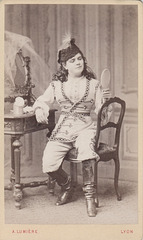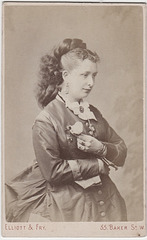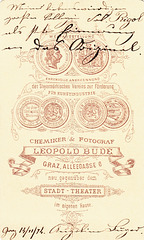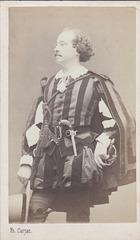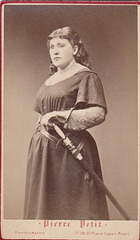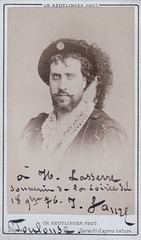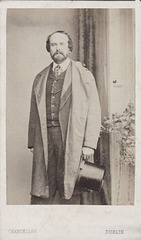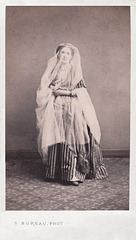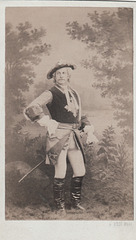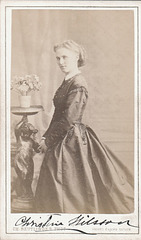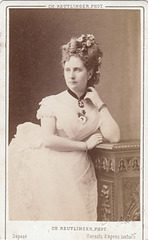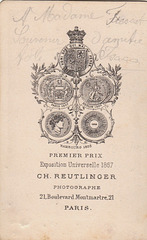Bialystok-Stavenuiter's photos
Célestine Galli-Marié by Bingham
| |
|
|
|
Célestine Galli-Marié, born Célestine Marié de l'Isle (1840-1905); French mezzo-soprano.
She was the daughter of the opera singer Félix Mécène Marié de l'Isle (1811-1882), who taught her singing. In 1859 she made her debut at Strassburg and in 1861 she performed at Lisbon. From 1862 until 1885 she was engaged at the Paris Opéra-Comique. She created various première-roles. The most known are Kaled in Maillart’s “Lara”(1864), Blandine in Gevaert’s “Le capitaine Henriot” (1864), Friday in Offenbach’s “Robinson Crusoé” (1867), Fantasio in Offenbach’s “Fantasio” (1872), Lazarillo in Massenet’s “Don César de Bazan” (1872) and Zanetto in Paladilhe’s “Le passant” (1872). She is however best remembered for creating the title-role in the opera “Mignon” (1866) by Ambroise Thomas (1866) and the title-role in “Carmen” by Georges Bizet (1875). These two roles made her world famous and from 1875 on she made guest appearances all over the world in these two opera’s. In 1885 she appeared in the 100th (gala)performance of Carmen at the Opéra-Comique. Here she ended her career in the same year. In 1890 she returned to the Opéra-Comique to sing in a fundraising performance to erect a monument to the composer Bizet.
The mezzo-soprano Paola Marié (1847-1919) was her younger sister and was also well known for the interpretations of Carmen and Mignon.
On the photo Galli-Marié is seen in " Les Rendez-vous bourgeois", an opera by the French (Maltese born) composer Nicolas Isouard (1773-1818), also known as Nicolò, Nicolò Isoiar or Nicolò de Malte. In 1873 Galli-Marié performed the role of César at the 500th performance of this opera at the Paris Opéra-Comique.
Célestine Galli-Marié by Lumière
| |
|
Célestine Galli-Marié, born Célestine Marié de l'Isle (1840-1905); French mezzo-soprano.
She was the daughter of the opera singer Félix Mécène Marié de l'Isle (1811-1882), who taught her singing. In 1859 she made her debut at Strassburg and in 1861 she performed at Lisbon. From 1862 until 1885 she was engaged at the Paris Opéra-Comique. She created various première-roles. The most known are Kaled in Maillart’s “Lara”(1864), Blandine in Gevaert’s “Le capitaine Henriot” (1864), Friday in Offenbach’s “Robinson Crusoé” (1867), Fantasio in Offenbach’s “Fantasio” (1872), Lazarillo in Massenet’s “Don César de Bazan” (1872) and Zanetto in Paladilhe’s “Le passant” (1872). She is however best remembered for creating the title-role in the opera “Mignon” (1866) by Ambroise Thomas (1866) and the title-role in “Carmen” by Georges Bizet (1875). These two roles made her world famous and from 1875 on she made guest appearances all over the world in these two opera’s. In 1885 she appeared in the 100th (gala)performance of Carmen at the Opéra-Comique. Here she ended her career in the same year. In 1890 she returned to the Opéra-Comique to sing in a fundraising performance to erect a monument to the composer Bizet.
The mezzo-soprano Paola Marié (1847-1919) was her younger sister and was also well known for the interpretations of Carmen and Mignon.
On the photo she is seen as Marie in “La fille du Regiment” by Donizetti.
Célestine Galli-Marié by Nadar (2)
| |
|
Célestine Galli-Marié, born Célestine Marié de l'Isle (1840-1905); French mezzo-soprano.
She was the daughter of the opera singer Félix Mécène Marié de l'Isle (1811-1882), who taught her singing. In 1859 she made her debut at Strassburg and in 1861 she performed at Lisbon. From 1862 until 1885 she was engaged at the Paris Opéra-Comique. She created various première-roles. The most known are Kaled in Maillart’s “Lara”(1864), Blandine in Gevaert’s “Le capitaine Henriot” (1864), Friday in Offenbach’s “Robinson Crusoé” (1867), Fantasio in Offenbach’s “Fantasio” (1872), Lazarillo in Massenet’s “Don César de Bazan” (1872) and Zanetto in Paladilhe’s “Le passant” (1872). She is however best remembered for creating the title-role in the opera “Mignon” (1866) by Ambroise Thomas (1866) and the title-role in “Carmen” by Georges Bizet (1875). These two roles made her world famous and from 1875 on she made guest appearances all over the world in these two opera’s. In 1885 she appeared in the 100th (gala)performance of Carmen at the Opéra-Comique. Here she ended her career in the same year. In 1890 she returned to the Opéra-Comique to sing in a fundraising performance to erect a monument to the composer Bizet.
The mezzo-soprano Paola Marié (1847-1919) was her younger sister and was also well known for the interpretations of Carmen and Mignon.
Blanche Cole by Elliott & Fry
| |
|
Blanche Cole (1851-1888); English soprano.
In 1869 she made her debut at the London Crystal Palace in the role of Amina in Bellini 's "La Sonnambula". She then changed her repertoire and concentrated only on roles from English operas or the English version of other operas. During her career she sang 21 roles in English versions of operas in London and the British provinces. In 1879 she organized her own opera company and undertook a tour through England. Later she joined the Carl Rosa Opera Company. Since 1868 she was married to the pianist Sidney Naylor. She died of dropsy at the age of 37
Angelina Luger by Leopold Bude
| |
|
Angelina Luger (1858-1910); German soprano/mezzo-soprano.
She received her vocal training from Ms. Richter in Munich and Ms. Weinlich-Tipka in Graz. It was also in Graz where she stood on the stage for the first time in 1875. After an engagement at the Hoftheater von Stuttgart, she sang the season 1881/82 at the Berliner Hofoper and in 1882/84 at the Opernhaus von Leipzig. In 1884 she was invited at the Opernhaus von Frankfurt am Main, where she had a spectacular success in her debut role of Mignon by Ambroise Thomas. There she remained until 1892 singing roles like Fides in "Le Prophète", the title role in "Carmen", Adriano in "Rienzi", Azucena in "Il Trovatore", the title role in "Die Königin von Saba", Selika in "L'Africaine", Brangäne in "Tristan und Isolde" and Leonore in "Fidelio". She made guest appearances at Vienna (1881), Dresden (1883), London (1884 Covent Garden), Mannheim (1885), Wiesbaden (1885) and Berlin (1890). In 1892, at the height of her career, she married the Count Totto and withdrew soon afterwards from the stage.
Angelina Luger's autograph at the back
| |
|
Angelina Luger (1858-1910); German soprano/mezzo-soprano
Dedication written and signed by Angelina Luger. The dedication reads as follows:
Meiner liebenswürdigen
großen Kollegin Frl. Rigol*
als zarte Erinnerung
an das Original.
Graz, 14.11.74 Angelina Luger
* "Fräulein Rigol" was a German actress, also known as Emma (Emmy) Teuber-Rigol.
Caroline Girard by Franck
| |
|
|
Caroline Girard (1830-?); French soprano.
In 1853 she made her debut at the Théâtre Lyrique were she was engaged until 1863. She performed at many premières: the title role in Gevaert's "Georgette" (1853), Georgette in Maillart's "Les Dragons de Villars" (1856), in Clapison's "Margot", Jacqueline in Gounod's "Le medecin malgré lui" (1858), in Sermet's "Gil Blas" (1860) and in many more (now completely forgotten) opera's. From 1863-1870 she was engaged at the Opéra-Comique where she created the role of Suzanne in Offenbach's "Robinson Crusoe" (1867). In 1869 she sang at the Offenbach première of "Vert-Vert". After 1878 she largely retired from the stage. In 1879 she created the role of the Duchesse Della Volta in Offenbach's "La fille du tambour-major" together with her daughter Juliette as Stella and her son-in-law Max Simon as Griolet.
She was the mother of the soprano Juliette (Simon-)Girard (1859-1954), who married the tenor Max Simon (1852-1923). The marriage ended in divorce (1894).
On the photo she is seen in her creator role of Gil Blas in Sermet's eponymous opera.
Achille-Felix Montaubry by Carjat
| |
|
Achille-Félix Montaubry (1826-1898); French tenor.
He started his musical career as an instrumentalist (violin and cello). After discovering his voice he studied singing at the Paris Conservatorium. From 1848 on he had successful engagements at Lille, Brussels, The Hague, Strassburg, Bordeaux and Marseille. In 1858 he was engaged at the Opéra-Comique in Paris. Here he sang at several world premières: in Thomas’ “Le roman d’Elvire” (1860), in Auber’s “La Circassienne” (1861), in David’s “Lalla-Roukh” (1862), in Maillart’s “Lara” (1864), in David’s “Le Saphir” (1865), in Bazin’s “Le voyage en Chine” (1865) and in Offenbach’s “Robinson Crusoé” (1867). In 1862 he performed the role of Bénédict at the première of Berlioz’s opera “Béatrice et Bénédict”. In 1874 he sang at the première of the 4-act version in Offenbach’s “Orphée aux enfers”. After retiring from the stage he left Paris for theatre management in the French province.
Gabrielle Krauss by Petit
| |
|
Gabrielle Krauss (1842-1906); Austrian soprano.
She was a pupil of Mathilde Marchesi. In 1859 -at the age of 17- she made her debut as Mathilde in Rossini's “William Tell” at the Vienna Hofoper. She continued her career in Vienna until 1867. After guest appearances in Italy and Russia she settled in Paris and performed at the “Grand Opera” and at the “Théâtre-Italien”. She created the title-role at the première of Mermet’s “Jeanne d’Arc” (1876), the role of Pauline in Gounod’s “Polyeucte” (1878), Hermosa in Gounod’s “Le tribut de Zamora” (1881), Catherine d’Aragon in Saint-Saëns “Henri VIII” (1883) and Dolores in Paladilhe’s “Patrie !” (1886). She was also a celebrated concert singer.
On the photo she is seen in her creator role of Jeanne d'Arc in Mermet's eponymous opera (1876).
Jean-Baptiste Faure by Reutlinger (4) with autogra…
| |
|
|
Jean-Baptiste Fauré (1830-1914); French baritone. In 1852 he made his debut at the Opéra-Comique -where he remained until 1860- as Pygmalion in Massé’s “Galathée”. He made his debut at Covent Garden in 1860 and at the Grand Opéra Paris in 1861.He created numerous operatic roles. The most known are Le Marquis d’Hérigny in Auber’s “Manon Lescaut (1856), Hoël in Meyerbeer’s “Dinorah” (1859), Nélusko in Meyerbeer’s “L'Africaine” (1865), Rodrigo in Verdi’s “Don Carlos” (1867) and Hamlet in the eponymous opera from Ambroise Thomas (1868). He was also a composer of songs of which “Crucifix” and “Les rameaux” are well known (recorded by Enrico Caruso). He was married to the soprano Constance-Caroline Lefebvre (1828-1905) who was engaged at the Opéra-Comique from 1849-1859.
The dedication written and signed by Faure is made to the journalist and author Henri Lassere (1828-1900).
Jean-Baptiste Faure by Disdéri (5)
| |
|
Jean-Baptiste Fauré (1830-1914); French baritone. In 1852 he made his debut at the Opéra-Comique -where he remained until 1860- as Pygmalion in Massé’s “Galathée”. He made his debut at Covent Garden in 1860 and at the Grand Opéra Paris in 1861.He created numerous operatic roles. The most known are Le Marquis d’Hérigny in Auber’s “Manon Lescaut (1856), Hoël in Meyerbeer’s “Dinorah” (1859), Nélusko in Meyerbeer’s “L'Africaine” (1865), Rodrigo in Verdi’s “Don Carlos” (1867) and Hamlet in the eponymous opera from Ambroise Thomas (1868). He was also a composer of songs of which “Crucifix” and “Les rameaux” are well known (recorded by Enrico Caruso). He was married to the soprano Constance-Caroline Lefebvre (1828-1905) who was engaged at the Opéra-Comique from 1849-1859.
Italo Gardoni by Chancellor
| |
|
Italo Gardoni (1821-1882); Italian tenor.
In 1840 he made his debut at Viadana in the title role of Donizetti’s “Roberto Devereux”. In the same year he performed in Turin and Berlin; in Berlin he sang the role of Rodrigo in Rossini’s “Otello” with the famous tenor Giovanni Battista Rubini as Otello. From 1841/43 he performed at Brescia and Milan, the season 1844/45 at the Grand Opéra Paris and in 1847 also in Paris at the Théâtre-Italien. Also in 1847 he made his London debut where he sang at Her Majesty's Theatre the role of Carlo in the world première of Verdi’s “I Masnadieri” (with Luigi Lablache as Massimiliano and Jenny Lind as Amalia). Until 1874 –the year of his retirement from the stage- he kept appearing at both London and Paris. He also made very successful guest appearances at St, Petersburg, Madrid, Amsterdam and Rome. In 1864 Gardoni was one of the 4 soloists in the first performance of Rossini's “Petite messe solennelle” with Carlotta and Barbara Marchisio and Luigi Agnesi. He was married to the daughter of the famous baritone Antonio Tamburini (1800-1876).
Marie-Julie Baretti by Bureau
| |
|
Marie-Julie Baretti, born Baretty (1838-1872); French soprano at the Théâtre Lyrique and the Opera Comique. She studied singing at the Conservatoire National de Paris. She sang in the première of Maillart's "Les pecheurs de Catane" (1860) and "Lara" (1864), Reyer's "La Statue" (1861) and David's "Le saphir" (1865).
On the photo she is seen in her creator role of Margyane in Reyer's "La Statue".
Edmond Duvernoy by Ken
| |
|
Edmond Duvernoy (1844-1927); French baritone (and pianist).
He was the son of the well known baritone Charles François Duvernoy (1796-1872) from whom he received his vocal training. In 1873 he made his debut at the Opéra Comique Paris as Mercutio in Gounod's "Roméo et Julliette". He created Moralès in the premiere of Bizet's "Carmen" in 1875; Bizet composed three versions of the "Mélodrame" in Act 1 for Duvernoy. In 1873 he sang Ganymède in Massé's "Galathée" alongside his future wife Mademoiselle Franck (Adèle Franck-Cahn), a soprano of the Opéra-Comique. Duvernoy and his wife moved to the Théâtre-Lyrique in 1877. Both of them participated in the private premiere (at Offenbach’s house) of "Les contes d'Hoffmann" on 18 May 1879; Edmond Duvernoy playing the piano and his wife singing the soprano roles. From 1887-1910 he had an appointment as vocal pedagogue at the Conservatoire National Paris.
Mathieu-Émile Balanqué by Constantin
| |
|
Mathieu-Émile Balanqué (1826-1866); French bass who created the role of Méphistophélès in the première of Gounod's "Faust" on 19 March 1859 at the Theatre-Lyrique Paris. He studied singing at the Conservatoire National de Paris with Gilbert Duprez. Until 1856 he performed in Brussels, Strasbourg and Toulouse, before he was engaged at the Théâtre-Lyrique in Paris. At this theatre he had already sung in 1852 the Chevalier de Romuald in the première of Gilbert Duprez's opera "Joanita" . This appearance could have been his stage debut. He sang at various world premières: as Francatrippa in Massé's "La Reine Topaze" (1856), as Méphistophélès in Gounod's "Faust" (1859), as Cecco in Mailart's "Les Pêcheurs de Catane" (1860), as Vulcain in Gounod's "Philémon et Baucis" (1860), Maître Jean in Gounod's "La Colombe (1860) and as Armgyad in Reyer's "La statue" (1861). Count Almaviva in Mozart's "Le nozze di Figaro" was one of his major stage roles.The end of his career developed disastrous. At the age of 35 he lost his voice. He then became a stage director at the "Théâtre d' Angers", which burnt down in 1865. He returned to Paris with his wife and five children and died one year later in great poverty. Three of his children were also professional singers: Réer and Charles were baritones and Blanche was a soprano (Opéra Comique).
Christine Nilsson by Reutlinger (7) with autograph
| |
|
Christine Nilsson (1843-1921); Swedish soprano.In 1864 she had her début as Violetta in “La Traviata” at the Theâtre-Lyrique in Paris. After this success she sang at major opera houses in London, Saint Petersburg, Vienna and New York In 1868 she created the role of Ophélie in Ambroise Thomas’ “Hamlet” at the Grand Opéra Paris and she sang the same role in the English première of Hamlet at Covent Garden in 1869. She also appeared in the Metropolitan Opera's inaugural performance on 22 October 1883 in Gounod's Faust.
Adele Isaac by Reutlinger
| |
|
Adèle Isaac (1854-1915); French soprano. She studied with the famous tenor Gilbert Duprez. In 1870 she made her debut at the Théâtre Montmartre in Massé's "Les Noces de Jeannette". After the end of the German-French war of 1870/71 she sang first at Liège, then in Brussels. Here she attracted attention singing the young sheperd in Wagner's "Tannhäuser" at the "La Monnaie" theater. In 1873 she was engaged by the Opéra-Comique, where she debuted as Marie in Donizetti's "La Fille du régiment". Especially in the period 1878/88 her career was very successful. She was much estimated as a Mozart interpreter (Susanna in "Le nozze di Figaro" and Zerlina in "Don Giovanni") and in the soprano parts of the operas by Thomas, Hérold, Halévy and Gounod. In 1881 she created the roles of Olympia, Antonia and Stella at the première of Offenbach's "Les Contes d'Hoffmann". In 1887 she created the role of Minka in Chabrier's "Le Roi malgré lui". In the years 1883/85 she was also very successful at the Grand Opéra Paris. She had a brilliant, virtuosic coloratura voice and shone in roles such as Juliette in Gounod's "Roméo et Juliette" and Violetta in Verdi's "La Traviata". After she married in 1887 businessman Charles Lelong her appearances became less frequent. In 1894, she retired from the stage and devoted herself to teaching.
Adele Isaac's autograph at the back
| |
|
Adèle Isaac (1854-1915); French soprano, who created the roles of Olympia, Antonia and Stella at the première of Offenbach's "Les Contes d'Hoffmann".
The dedication written and signed by Adele Isaac reads as follows:
A Madame Fressat
Souvenir d'amitié
Adele Isaac
Jump to top
- ipernity © 2007-2024
- Help & Contact
|
Club news
|
About ipernity
|
History |
ipernity Club & Prices |
Guide of good conduct
Donate | Group guidelines | Privacy policy | Terms of use | Statutes | In memoria -
Facebook
Twitter


